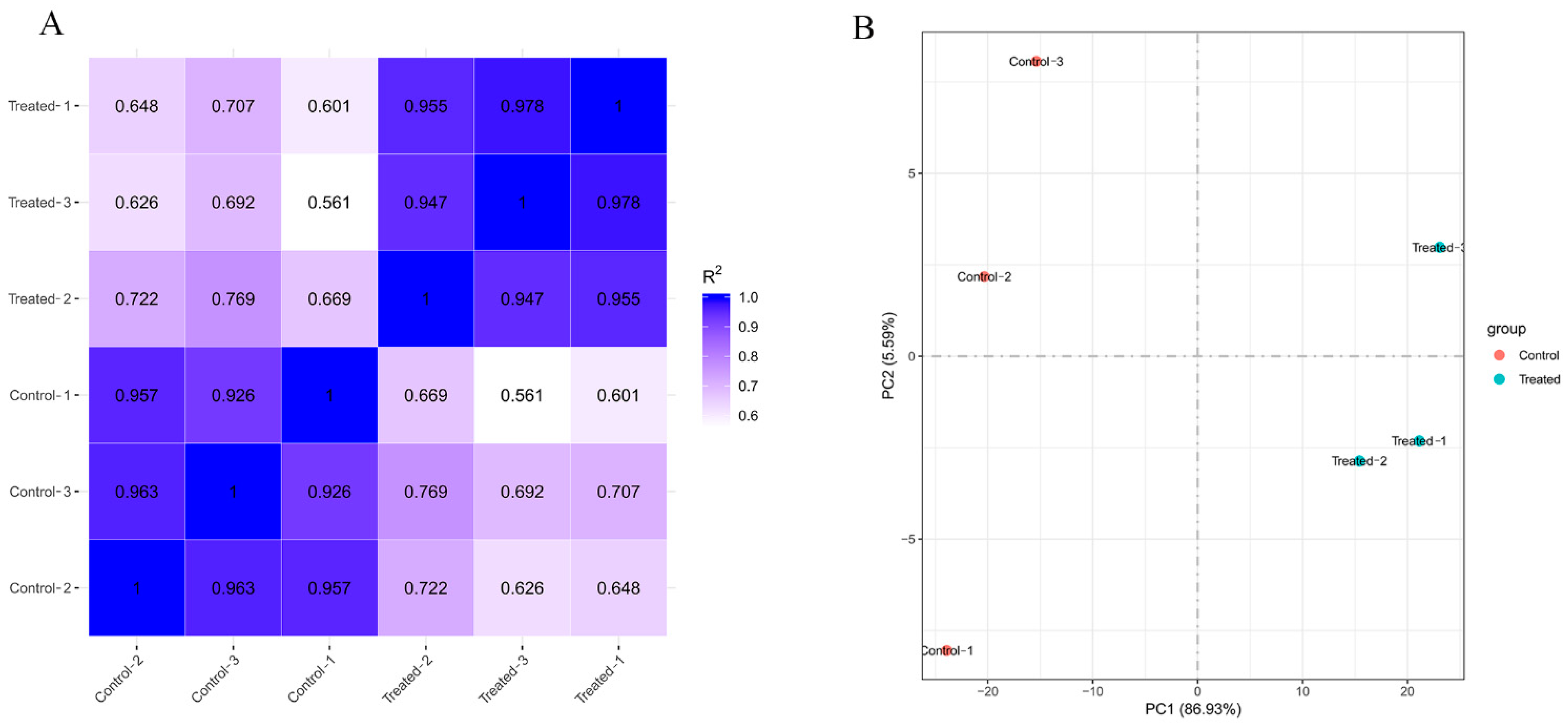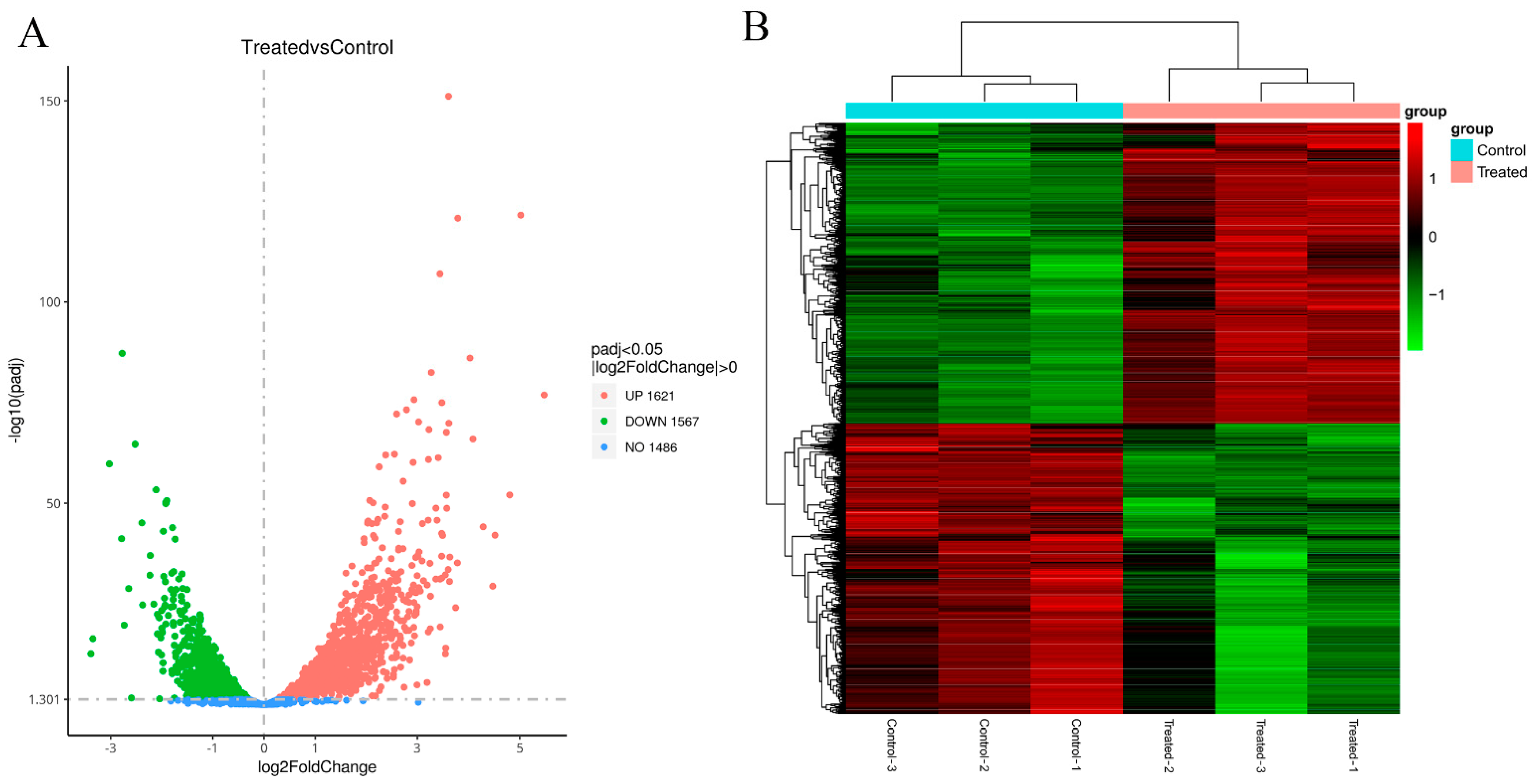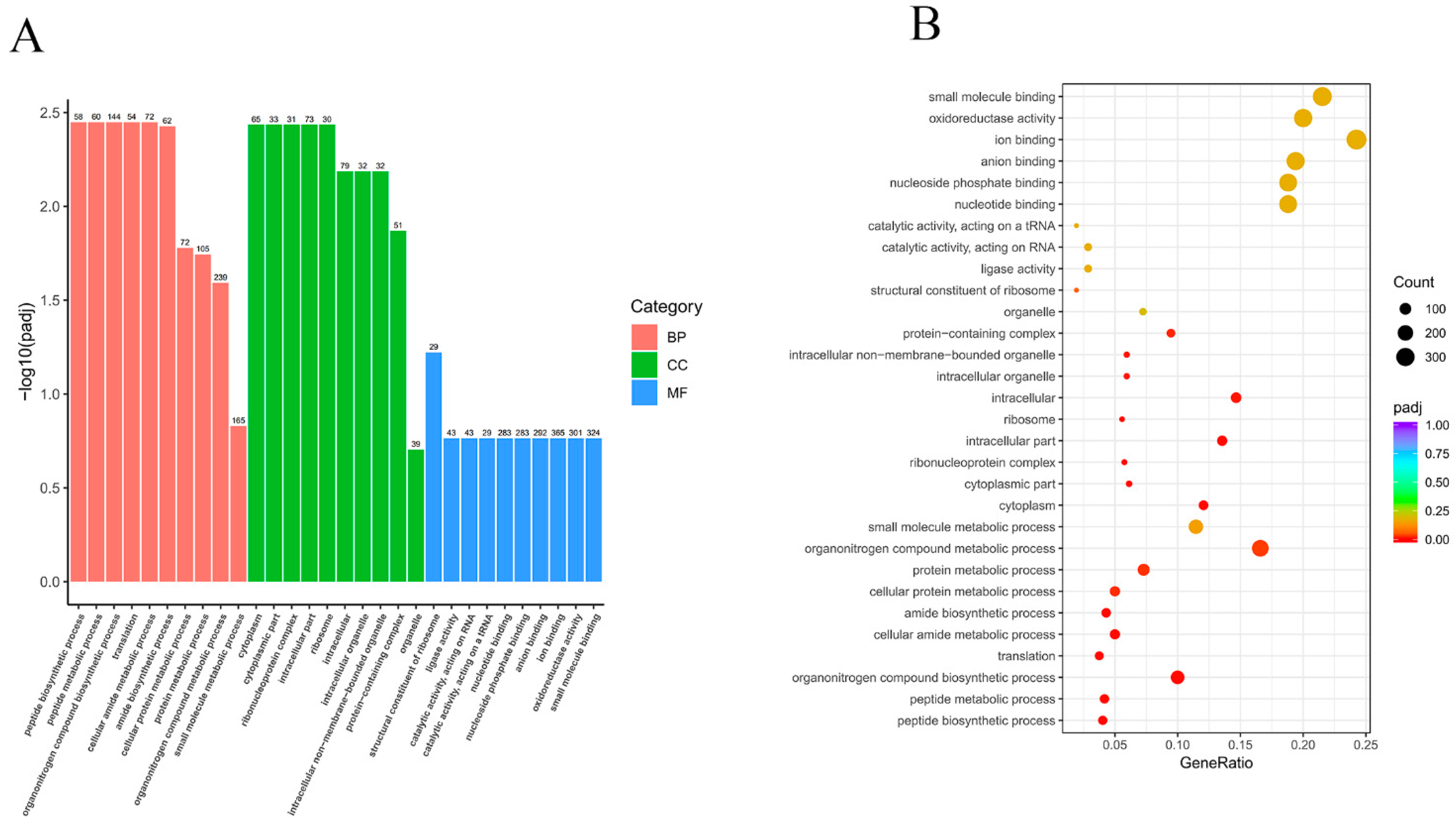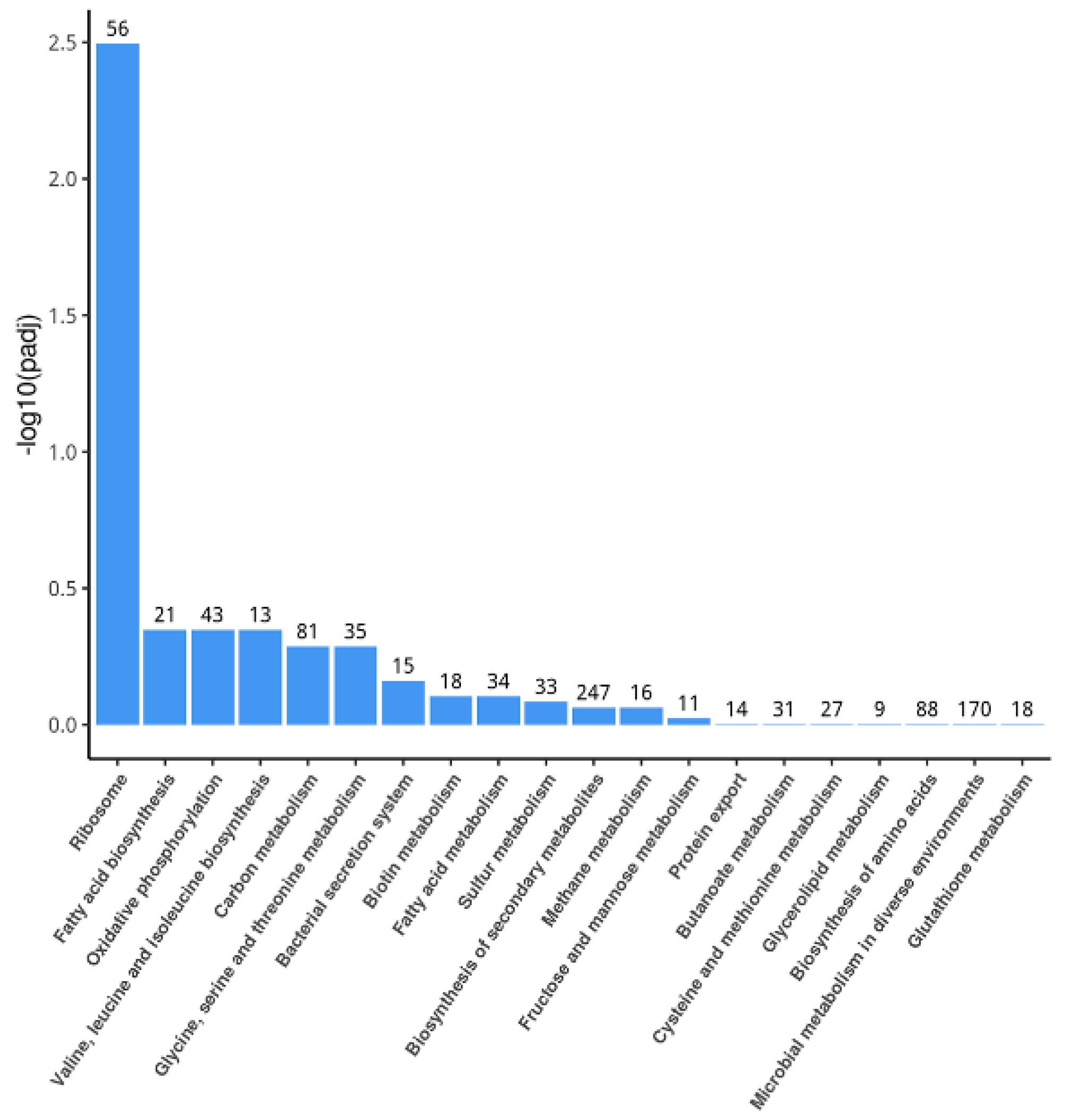Antibacterial Mechanism of Linalool against Pseudomonas fragi: A Transcriptomic Study
Abstract
:1. Introduction
2. Materials and Methods
2.1. Cells and Culture Conditions
2.2. RNA Isolation and cDNA Library Construction
2.3. Transcriptome Sequencing and Quantification
2.4. Differentially Expressed Gene (DEG) Screening and Analysis
3. Results
3.1. Data Processing and Analysis
3.2. Diversity Analysis
3.3. DEGs
3.4. GO Enrichment Analysis
3.5. KEGG Pathway Analysis
4. Discussion
5. Conclusions
Author Contributions
Funding
Institutional Review Board Statement
Informed Consent Statement
Data Availability Statement
Conflicts of Interest
References
- Fritz, S.; See, L.; Carlson, T.; Haklay, M.M.; West, S.E. Citizen science and the United Nations Sustainable Development Goals. Nat. Sustain. 2019, 2, 922–930. [Google Scholar] [CrossRef]
- Kang, S.; Shi, C.; Chang, J.; Kong, F.; Li, M.; Guan, B.; Zhang, Z.; Shi, X.; Zhao, H.; Peng, Y. Label free-based proteomic analysis of the food spoiler Pseudomonas fluorescens response to lactobionic acid by SWATH-MS. Food Control. 2021, 123, 107834. [Google Scholar] [CrossRef]
- Bahmid, N.A.; Heising, J.; Fogliano, V.; Dekker, M. Packaging design using mustard seeds as a natural antimicrobial: A study on inhibition of Pseudomonas fragi in liquid medium. Foods 2020, 9, 789. [Google Scholar] [CrossRef] [PubMed]
- Agrimonti, C.; White, J.C.; Tonetti, S.; Marmiroli, N. Antimicrobial activity of cellulosic pads amended with emulsions of essential oils of oregano, thyme and cinnamon against microorganisms in minced beef meat. Int. J. Food Microbiol. 2019, 305, 108246. [Google Scholar] [CrossRef]
- Papadopoulou, O.S.; Iliopoulos, V.; Mallouchos, A.; Panagou, E.Z.; Chorianopoulos, N.; Tassou, C.C.; Nychas, G.E. Spoilage potential of Pseudomonas (P. fragi, P. putida) and LAB (Leuconostoc mesenteroides, Lactobacillus sakei) strains and their volatilome profile during storage of sterile pork meat using GC/MS and data analytics. Foods 2020, 9, 633. [Google Scholar] [CrossRef]
- Chen, Q.; Zhang, M.; Chen, M.; Li, M.; Zhang, H.; Song, P.; An, T.; Yue, P.; Gao, X. Influence of Eurotium cristatum and Aspergillus niger individual and collaborative inoculation on volatile profile in liquid-state fermentation of instant dark teas. Food Chem. 2021, 350, 129234. [Google Scholar] [CrossRef]
- He, F.; Li, K.; Zhang, X.; Yang, Y.; Fang, Y.; Xiang, F. Components and antibacterial activity of a novel essential oil from the nutrient broth of Eremothecium ashbyii H4565. LWT 2019, 101, 389–394. [Google Scholar] [CrossRef]
- Varia, R.D.; Patel, J.H.; Modi, F.D.; Vihol, P.D.; Bhavsar, S.K. In vitro and in vivo antibacterial and anti-inflammatory properties of linalool. Int. J. Curr. Microbiol. Appl. Sci. 2020, 9, 1481–1489. [Google Scholar] [CrossRef]
- Guo, F.; Chen, Q.; Liang, Q.; Zhang, M.; Chen, W.; Chen, H.; Yun, Y.; Zhong, Q.; Chen, W. Antimicrobial activity and proposed action mechanism of linalool against Pseudomonas fluorescens. Front. Microbiol. 2021, 49, 562094. [Google Scholar] [CrossRef]
- He, R.; Chen, W.; Chen, H.; Zhong, Q.; Zhang, H.; Zhang, M.; Chen, W. Antibacterial mechanism of linalool against L. monocytogenes, a metabolomic study. Food Control 2022, 132, 108533. [Google Scholar] [CrossRef]
- Liu, X.; Cai, J.; Chen, H.; Zhong, Q.; Hou, Y.; Chen, W.; Chen, W. Antibacterial activity and mechanism of linalool against Pseudomonas aeruginosa. Microb. Pathog. 2020, 141, 103980. [Google Scholar] [CrossRef] [PubMed]
- Ghosh, T.; Srivastava, S.K.; Gaurav, A.; Kumar, A.; Kumar, P.; Yadav, A.S.; Pathania, R.; Navani, N.K. A combination of linalool, vitamin C, and copper synergistically triggers reactive oxygen species and DNA damage and inhibits Salmonella enterica subsp. enterica Serovar Typhi and Vibrio fluvialis. Appl. Environ. Microb. 2019, 85, e2418–e2487. [Google Scholar]
- Noh, S.; Choi, E.; Hwang, C.; Jung, J.H.; Kim, S.; Kim, B. Dietary compounds for targeting prostate cancer. Nutrients 2019, 11, 2401. [Google Scholar] [CrossRef] [PubMed] [Green Version]
- Xu, L.; Zhang, C.; Xu, P.; Wang, X.C. Mechanisms of ultraviolet disinfection and chlorination of Escherichia coli: Culturability, membrane permeability, metabolism, and genetic damage. J. Environ. Sci. China 2018, 65, 356–366. [Google Scholar] [CrossRef] [PubMed]
- Hansen, K.D.; Brenner, S.E.; Sandrine, D. Biases in Illumina transcriptome sequencing caused by random hexamer priming. Nucleic Acids Res. 2010, 38, e131. [Google Scholar] [CrossRef] [Green Version]
- Lee, C.S.; Ungewickell, A.; Bhaduri, A.; Qu, K.; Khavari, P.A. Transcriptome sequencing in Sezary syndrome identifies Sezary cell and mycosis fungoides-associated lncRNAs and novel transcripts. Blood 2012, 120, 3288. [Google Scholar] [CrossRef] [Green Version]
- Yu, Y.; Dong, J.; Wang, Y.; Gong, X. RNA-seq analysis of antibacterial mechanism of Cinnamomum camphora essential oil against Escherichia coli. Peerj 2021, 9, e11081. [Google Scholar] [CrossRef]
- Jun-Young, P.; Su-Kyung, J.; Kyung-Min, P.; Yu, H.; Bai, J.; Sangryeol, R.; Chang, P.S. Transcriptomic analysis of Staphylococcus aureus under the stress condition of antibacterial erythorbyl laurate by RNA sequencing. Food Control 2018, 96, S963185694. [Google Scholar]
- Lathen, D.R.; Merrill, C.B.; Rothenfluh, A. Flying Together: Drosophila as a Tool to Understand the Genetics of Human Alcoholism. Int. J. Mol. Sci. 2020, 21, 6649. [Google Scholar] [CrossRef]
- Mcdevitt, D.; Rosenberg, M. Exploiting genomics to discover new antibiotics. Trends Microbiol 9:611–617. Trends Microbiol. 2002, 9, 611–617. [Google Scholar] [CrossRef]
- Li, Y.; He, R.; Cai, J.; Chang, J.; Chen, W. Antibacterial Activity and Mechanism of Linalool against Pseudomonas fragi. J. Food Sci. Technol. 2020, 141, 103980. [Google Scholar]
- Liu, Y.; Gao, W.; Wang, Y.; Wu, L.; Liu, X.; Yan, T.; Alm, E.; Arkin, A.; Thompson, D.K.; Fields, M.W. Transcriptome analysis of Shewanella oneidensis MR-1 in response to elevated salt conditions. J. Bacteriol. 2005, 187, 2501–2507. [Google Scholar] [CrossRef] [PubMed] [Green Version]
- Milohanic, E.; Glaser, P.; Coppée, J.Y.; Frangeul, L.; Vega, Y.; Vázquez Boland, J.A.; Kunst, F.; Cossart, P.; Buchrieser, C. Transcriptome analysis of Listeria monocytogenes identifies three groups of genes differently regulated by PrfA. Mol. Microbiol. 2003, 47, 1613–1625. [Google Scholar] [CrossRef] [PubMed] [Green Version]
- Polissi, A.; De Laurentis, W.; Zangrossi, S.; Briani, F.; Longhi, V.; Pesole, G.; Dehò, G. Changes in Escherichia coli transcriptome during acclimatization at low temperature. Res. Microbiol. 2003, 154, 573–580. [Google Scholar] [CrossRef]
- Gao, Z.; Zhong, W.; Liu, T.; Zhao, T.; Guo, J. Global Proteomic Analysis of Listeria monocytogenes’ Response to Linalool. Foods 2021, 10, 2449. [Google Scholar] [CrossRef]
- Prakash, A.; Vadivel, V.; Rubini, D.; Nithyanand, P. Antibacterial and antibiofilm activities of linalool nanoemulsions against Salmonella Typhimurium. Food Biosci. 2019, 28, 57–65. [Google Scholar] [CrossRef]
- Blaskó, Á.; Gazdag, Z.; Gróf, P.; Máté, G.; Sárosi, S.; Krisch, J.; Vágvölgyi, C.; Makszin, L.; Pesti, M. Effects of clary sage oil and its main components, linalool and linalyl acetate, on the plasma membrane of Candida albicans: An in vivo EPR study. Apoptosis 2017, 22, 175–187. [Google Scholar] [CrossRef]
- Nichols, W.K.; Prosser, F.H. Induction of ornithine decarboxylase in macrophages by bacterial lipopolysaccharides (LPS) and mycobacterial cell wall material. Life Sci. 1980, 27, 913–920. [Google Scholar] [CrossRef]
- Murphy, K.; Park, A.J.; Hao, Y.; Brewer, D.; Lam, J.S.; Khursigara, C.M. Influence of O Polysaccharides on Biofilm Development and Outer Membrane Vesicle Biogenesis in Pseudomonas aeruginosa PAO1. J. Bacteriol. 2014, 196, 1306–1317. [Google Scholar]
- Sharma, P.; Varma, R.; Sarasij, R.C.; Ira; Gousset, K.; Krishnamoorthy, G.; Rao, M.; Mayor, S. Nanoscale Organization of Multiple GPI-Anchored Proteins in Living Cell Membranes. Cell 2004, 116, 589. [Google Scholar] [CrossRef] [Green Version]
- Miryala, S.K.; Anbarasu, A.; Ramaiah, S. Gene interaction network to unravel the role of gut bacterial species in cardiovascular diseases: E. coli O157: H7 host-bacterial interaction study. Comput. Biol. Med. 2021, 133, 104417. [Google Scholar] [CrossRef] [PubMed]
- Li, L.; Hu, K.; Hong, B.; Lu, X.; Qian, D. The inhibitory effect of Bacillus amyloliquefaciens L1 on Aeromonas hydrophila and its mechanism. Aquaculture 2021, 539, 736590. [Google Scholar] [CrossRef]
- Shaw, G.W.S.A. Electrophoretic charaterization of ATP-sulfate adenylyltransferase (ATP-sulfurylase) using acrylamide gels. Anal. Biochem. 1972, 48, 259–265. [Google Scholar]
- Navarro-Suarez, A.M.; Hidalgo-Acosta, J.C.; Fadini, L.; Feliu, J.M.; Sua Rez-Herrera, M.F. Electrochemical Oxidation of Hydrogen on Basal Plane Platinum Electrodes in Imidazolium Ionic Liquids. J. Phys. Chem. C 2011, 115, 7. [Google Scholar] [CrossRef]
- Wang, D.; Safferling, M.; Lemieux, M.J.; Griffith, H.; Chen, Y.; Li, X. Practical aspects of overexpressing bacterial secondary membrane transporters for structural studies. Biochim. Biophys. Acta Biomembr. 2003, 1610, 23–36. [Google Scholar] [CrossRef] [Green Version]




| Gene Name | Description | Log2 (Fold Change) | P | P adj |
|---|---|---|---|---|
| RS12095 | N-acetyltransferase | 3.61 | 1.56 × 10−155 | 7.30 × 10−152 |
| RS19715 | biopolymer transporter ExbD | 5.02 | 1.06 × 10−125 | 2.49 × 10−122 |
| cysD | sulphate adenylyltransferase subunit CysD | 3.79 | 8.97 × 10−125 | 1.40 × 10−121 |
| RS20760 | extracellular solute-binding protein | 3.44 | 8.44 × 10−111 | 9.87 × 10−108 |
| RS05965 | Lrp/AsnC family transcriptional regulator | −2.77 | 6.23 × 10−91 | 5.83 × 10−88 |
| rpsT | 30S ribosomal protein S20 | 4.03 | 1.10 × 10−89 | 8.56 × 10−87 |
| RS19705 | TonB-dependent receptor | 3.27 | 4.91 × 10−86 | 3.28 × 10−83 |
| RS08005 | phosphate ABC transporter substrate-binding protein | 5.48 | 2.21 × 10−80 | 1.29 × 10−77 |
| RS12090 | 1-acyl-sn-glycerol-3-phosphate acyltransferase | 2.94 | 3.87 × 10−79 | 2.01 × 10−76 |
| RS10370 | SCP2 sterol-binding domain-containing protein | 3.48 | 2.29 × 10−78 | 1.07 × 10−75 |
| RS08405 | F0F1 ATP synthase subunit delta | 2.79 | 1.48 × 10−76 | 6.29 × 10−74 |
| cysN | sulphate adenylyltransferase subunit CysN | 2.59 | 1.80 × 10−75 | 7.01 × 10−73 |
| RS00275 | ABC transporter substrate-binding protein | 3.03 | 1.85 × 10−73 | 6.65 × 10−71 |
| groL | chaperonin GroEL | 3.62 | 4.20 × 10−73 | 1.40 × 10−70 |
| RS00755 | malate dehydrogenase | 3.23 | 1.70 × 10−71 | 5.30 × 10−69 |
| RS04250 | hypothetical protein | 3.57 | 8.84 × 10−71 | 2.58 × 10−68 |
| RS08110 | hypothetical protein | 4.09 | 4.11 × 10−69 | 1.13 × 10−66 |
| trxB | thioredoxin-disulphide reductase | 2.55 | 2.70 × 10−65 | 6.65 × 10−63 |
| RS19700 | MotA/TolQ/ExbB proton channel family protein | 2.38 | 4.53 × 10−65 | 1.06 × 10−62 |
| RS18445 | YggL family protein | 3.41 | 2.21 × 10−64 | 4.91 × 10−62 |
| RS06165 | hypothetical protein | 3.22 | 6.39 × 10−64 | 1.36 × 10−61 |
| RS08105 | LysR family transcriptional regulator | 2.92 | 3.53 × 10−63 | 7.18 × 10−61 |
| fpr | ferredoxin-NADP reductase | 2.25 | 4.97 × 10−62 | 9.29 × 10−60 |
| sucC | ADP-forming succinate--CoA ligase subunit beta | 2.72 | 1.91 × 10−58 | 3.43 × 10−56 |
| RS13000 | flagellar basal body rod protein FlgF | −2.11 | 2.79 × 10−56 | 4.82 × 10−54 |
| RS12740 | putative porin | 4.80 | 5.39 × 10−55 | 9.00 × 10−53 |
| RS22490 | co-chaperone GroES | 3.57 | 6.21 × 10−55 | 1.00 × 10−52 |
| RS08580 | NADPH:quinone reductase | 2.07 | 1.34 × 10−53 | 2.09 × 10−51 |
| RS05125 | transglycosylase domain-containing protein | −1.90 | 1.58 × 10−53 | 2.38 × 10−51 |
| RS06800 | methylcrotonoyl-CoA carboxylase | −1.92 | 4.51 × 10−53 | 6.59 × 10−51 |
| eco | serine protease inhibitor ecotin | 2.13 | 5.84 × 10−53 | 8.27 × 10−51 |
| RS20605 | dienelactone hydrolase family protein | 2.90 | 9.24 × 10−53 | 1.27 × 10−50 |
| KEGGID | Description | P | Padj | Count | Up | Down |
|---|---|---|---|---|---|---|
| pfz03010 | Ribosome | 4.01 × 10−5 | 0.003207 | 56 | 55 | 1 |
| pfz00061 | Fatty acid biosynthesis | 0.013608 | 0.450221 | 21 | 14 | 7 |
| pfz00190 | Oxidative phosphorylation | 0.019701 | 0.450221 | 43 | 37 | 6 |
| pfz00290 | Valine, leucine and isoleucine biosynthesis | 0.022511 | 0.450221 | 13 | 9 | 4 |
| pfz01200 | Carbon metabolism | 0.037621 | 0.515821 | 81 | 59 | 22 |
| pfz00260 | Glycine, serine and threonine metabolism | 0.038687 | 0.515821 | 35 | 19 | 16 |
| pfz03070 | Bacterial secretion system | 0.060324 | 0.689417 | 15 | 14 | 1 |
| pfz00780 | Biotin metabolism | 0.086515 | 0.784892 | 18 | 10 | 8 |
| pfz01212 | Fatty acid metabolism | 0.0883 | 0.784892 | 34 | 18 | 16 |
| pfz00920 | Sulfur metabolism | 0.102724 | 0.821793 | 33 | 19 | 14 |
Publisher’s Note: MDPI stays neutral with regard to jurisdictional claims in published maps and institutional affiliations. |
© 2022 by the authors. Licensee MDPI, Basel, Switzerland. This article is an open access article distributed under the terms and conditions of the Creative Commons Attribution (CC BY) license (https://creativecommons.org/licenses/by/4.0/).
Share and Cite
Li, Y.; Ren, F.; Chen, D.; Chen, H.; Chen, W. Antibacterial Mechanism of Linalool against Pseudomonas fragi: A Transcriptomic Study. Foods 2022, 11, 2058. https://doi.org/10.3390/foods11142058
Li Y, Ren F, Chen D, Chen H, Chen W. Antibacterial Mechanism of Linalool against Pseudomonas fragi: A Transcriptomic Study. Foods. 2022; 11(14):2058. https://doi.org/10.3390/foods11142058
Chicago/Turabian StyleLi, Yuansong, Fei Ren, Da Chen, Haiming Chen, and Wenxue Chen. 2022. "Antibacterial Mechanism of Linalool against Pseudomonas fragi: A Transcriptomic Study" Foods 11, no. 14: 2058. https://doi.org/10.3390/foods11142058
APA StyleLi, Y., Ren, F., Chen, D., Chen, H., & Chen, W. (2022). Antibacterial Mechanism of Linalool against Pseudomonas fragi: A Transcriptomic Study. Foods, 11(14), 2058. https://doi.org/10.3390/foods11142058







